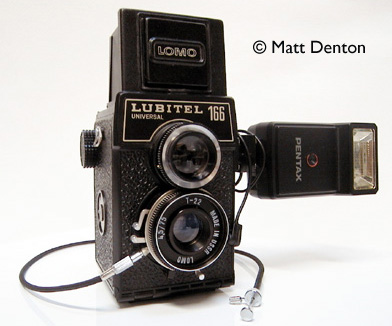- Produced all 166 models 1976-1996 (1994) LOMO, St. Petersburg, Russia
- Film type 120
- Picture size 6cm x 6cm (6 x 4.5 with mask)
- Weight 16.4oz (464.9g)
- Lens (taking) LOMO T-22 75mm f4.5 (stops to f22)
- Filter Size 40.5mm threaded
- Focal range 1.3m to infinity
- Shutter ZT-8 (Synchro-Compur copy?)
- Shutter speeds B, 1/15 – 1/250
- Viewfinder TLR
- Exposure meter none
- Self-timer
- Accessory shoe, PC sync connection
Overview
The Lubitel was my entry into medium-format, at the time (1995, I think) the least-expensive method I could think of. They’re no longer in production, but I got mine new for $25 or $30 mail-order after having passed on one for $20 at Photo Supply in SOMA (great store!) and of course by the time I changed my mind they were sold out. If I were starting now and wanted to get into medium format for less than $25 US I would probably go on ebay and look for a Agfa Plenax or Ansco Viking if I wanted an option for a wide aspect ratio (6×9), or a nice Ricohflex or Ciroflex if I wanted a TLR.
THAT SAID, this is a good little camera and takes nice sharp pictures with its single-coated lens. The controls are a little cheesy but they work fine and what do you expect from a ‘toy’ camera anyway. Easiest to use with a short cable release. Nothing preventing double-exposures like on the Voigtlander Brilliant, the Lubitel’s original inspiration (the original Lubitel looks almost identical to a Brilliant). HOWEVER it has something dating back to the first Lubitel that the brilliant doesn’t, which is a geared focusing lens coupled to the taking lens. Real focusing, not zone focus! (Of course you need to flip up the center magnifier to even see what’s in focus.) It can also drive an electronic flash (pictured). It’s a good little starter TLR, just what I was looking for, a practice camera to use before I stepped up to a real TLR like the Ikoflex. Last note: I’ve heard the pictures from this camera compared to those of a Hasselblad more than once. I don’t know if that’s a reflection of the quality of the pictures so much as that the Hassys are considered the gold standard for medium format…don’t shoot the messenger, I don’t have a Hassy and never really intend to so I can’t do my own comparison. But I certainly think the pictures from a Lubitel turn out pretty darn good.
Tips & Tricks
The wind knob is not a focus wheel, keep your eye on the red window…there is no auto frame couter, believe me you can make multiple exposures very easily. (Sometimes this is a good thing, sometimes not.) For all TLRs I recommend you use a short cable release, it’s MUCH easier and will keep your pictures sharp, as it’s very tricky (virtually impossible, I would say) to handhold a TLR and release the shutter without moving the camera. Here on the Lubitel where all the controls look the same and are very close together it’s definitely recommended. Plus the Lubitel is so lightweight it’s all you can do to keep it steady. And as with pretty much any TLR get used to seeing your viewfinder image in reverse (I actually think this helps your composition skills as it forces you to really see what’s in the viewfinder).
Another tip sent in by a faithful reader is that some easy modifications can help the light-tightness and picture quality, namely that gluing felt or velvet strips inside the box helps reduce reflections from what is otherwise somewhat shiny plastic. I guess you could paint it with matte black model paint too. I’ve also heard of doing that with the Smena and other plastic cameras of the type.
Lost your 645 mask? Rafael of rafcamera.com has new replacments.
Truth in Advertising
I’ve since sold this camera to a young lady who was eager to get started in medium format. It served me well while I had it, but once I had a small collection of professional TLRs (and SLRs, and rangefinders, and…) to choose from I realized I wouldn’t be needing it anymore.
Related Links
- A little history on the Lubitel
- The Lubitel 166 Resource Page
- Lubitel tips from lomography.com
- The manual (I’ve misplaced mine but I think it was in Russian anyway)
- Rafael of rafcamera.com sells accessories for the Moskva and Lubitel.
